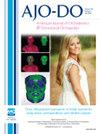头颅x线片轮廓线准确性。
IF 3
2区 医学
Q1 DENTISTRY, ORAL SURGERY & MEDICINE
American Journal of Orthodontics and Dentofacial Orthopedics
Pub Date : 2025-03-17
DOI:10.1016/j.ajodo.2025.02.009
引用次数: 0
摘要
本研究通过将侧位头颅x线片中的面部软组织轮廓线与来自三维照片的真实轮廓线进行比较,来研究面部软组织轮廓线的准确性。方法:对100例正畸患者的既往记录进行前瞻性方法学研究。通过对镜像三维曲面模型的最佳拟合近似,定义真中矢状面,得到真剖面。在每个轮廓图像上绘制两条曲线,并在其上放置地标和滑动半地标。这导致每个患者有2个轮廓地标配置,使用Procrustes叠加。与真实参考相比,相应地标之间的普洛克氏距离被用作评估头侧轮廓线准确性的度量。结果:平均而言,头侧测量线与实际轮廓线(100,000个排列;P = 0.031;中位地标间距离0.84 mm)。然而,在评估个体患者时,头侧轮廓线明显偏离真实轮廓,40%的相应标志之间的距离为> - 1mm, 10%为> - 2mm。性别之间或年轻和老年患者之间(8.0-12.5岁vs 12.5-55.0岁)没有差异。然而,两种x线设备之间的差异很小(中位数,0.18 mm;结论:平均而言,侧位头颅x线片可以充分反映面部轮廓,但当考虑到个别患者时,通常会出现临床显着错误。因此,侧位头颅造影在评估面部软组织轮廓时应谨慎使用。本文章由计算机程序翻译,如有差异,请以英文原文为准。
Profile line accuracy in cephalometric radiographs
Introduction
This study investigates the accuracy of facial soft-tissue profile lines in lateral cephalometric radiographs by comparing them to true profile lines derived from 3-dimensional photographs.
Methods
This prospective methodological study was performed on preexisting records of 100 orthodontic patients. The true profiles were obtained by defining the true midsagittal plane through best-fit approximation of mirrored 3-dimensional surface models. Two curves were drawn on each profile image, and landmarks and sliding semilandmarks were placed on them. This resulted in 2 profile landmark configurations per patient, which were superimposed using Procrustes superimposition. The Procrustes distances between corresponding landmarks were used as a metric to assess the accuracy of the cephalometric profile line, as compared with the true reference.
Results
On average, there were small statistically significant differences between the cephalometric and the actual profile lines (100,000 permutations; P = 0.031; median interlandmark distance, 0.84 mm). However, when assessing individual patients, the cephalometric profile line deviated significantly from the true profile, with 40% of the distances between corresponding landmarks being >1 mm and 10% being >2 mm. There were no differences between the sexes or between younger and older patients (aged 8.0-12.5 vs 12.5-55.0 years). However, there were small differences between 2 x-ray devices (median, 0.18 mm; P <0.001), which often exceeded 1 mm at the soft-tissue nasion area, probably because of the cephalostat.
Conclusions
On average, the lateral cephalometric radiographs might provide an adequate representation of the facial profile, but when individual patients are considered, there is often a clinically significant error. Thus, lateral cephalograms should be used with caution to evaluate the facial soft-tissue profile.
求助全文
通过发布文献求助,成功后即可免费获取论文全文。
去求助
来源期刊
CiteScore
4.80
自引率
13.30%
发文量
432
审稿时长
66 days
期刊介绍:
Published for more than 100 years, the American Journal of Orthodontics and Dentofacial Orthopedics remains the leading orthodontic resource. It is the official publication of the American Association of Orthodontists, its constituent societies, the American Board of Orthodontics, and the College of Diplomates of the American Board of Orthodontics. Each month its readers have access to original peer-reviewed articles that examine all phases of orthodontic treatment. Illustrated throughout, the publication includes tables, color photographs, and statistical data. Coverage includes successful diagnostic procedures, imaging techniques, bracket and archwire materials, extraction and impaction concerns, orthognathic surgery, TMJ disorders, removable appliances, and adult therapy.

 求助内容:
求助内容: 应助结果提醒方式:
应助结果提醒方式:


